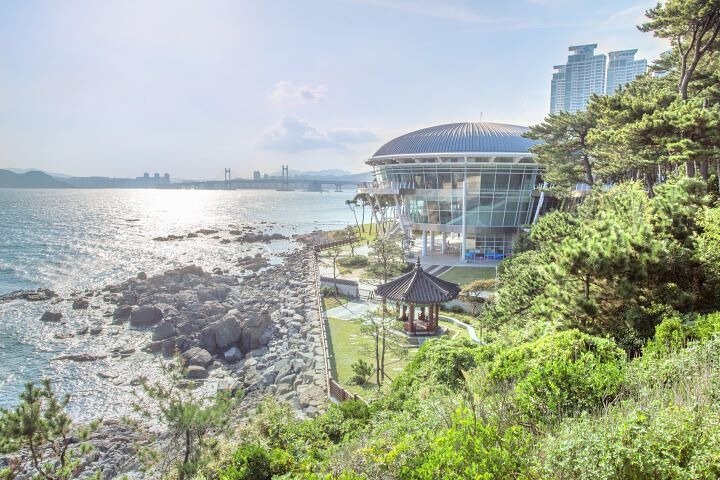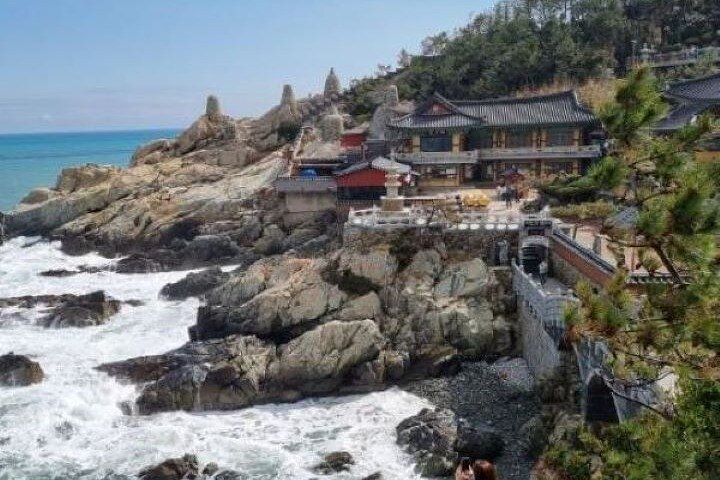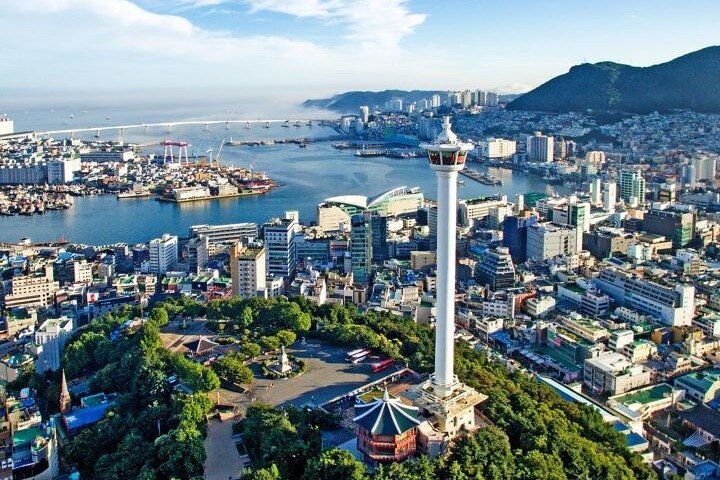Experience the best of Busan in this 3-day private tour. Explore historic streets, modern skyscrapers, and local markets. Discover hidden gems like fishing coast villages, UNESCO temples, and hot springs. Perfect for small groups.
Experience the best of Busan in this 3-day private tour. Explore historic streets, modern skyscrapers, and local markets. Discover hidden gems like fishing coast villages, UNESCO temples, and hot springs. Perfect for small groups.
Pick up at the Busan Hotel or Busan KTX train station/Airport - Busan East - Busan Hotel check-in
Haedong Yonggungsa - Located on the northeastern coast of Busan, Haedong Yonggungsa Temple is a unique attraction as it is one of the few temples in Korea situated by the sea, with most being in the mountains. Established in 1376 by the esteemed…
Pick up at the Busan Hotel or Busan KTX train station/Airport - Busan East - Busan Hotel check-in
Haedong Yonggungsa - Located on the northeastern coast of Busan, Haedong Yonggungsa Temple is a unique attraction as it is one of the few temples in Korea situated by the sea, with most being in the mountains. Established in 1376 by the esteemed Buddhist teacher Naong during the Goryeo dynasty, the temple features the Seawater Great Goddess Buddha, Daeungjeon Main Sanctuary, Yongwangdang Shrine, Gulbeop Buddhist Sanctum (housed in a cave), and a three-story pagoda with four lions overlooking the ocean. Many visit on New Year’s Day to make wishes as the sun rises. April is particularly beautiful with cherry blossoms, and the temple is illuminated with lanterns during Buddha’s birthday in the fourth lunar month.
Daebyeon Port Entrance - Recognized as one of the 100 beautiful fishing villages by the Ministry of Oceans and Fisheries, Daebyeon Port hosts the anchovy festival, celebrating Gijang’s specialty. Anchovy Theme Square, the festival’s main venue, features iconic towers and stunning sculptures with lighting, music, and fountains. Visitors can enjoy abalone porridge, live seafood, and shop for dried seafood.
Gijang Market - This outdoor market offers a variety of products, including fishery and agricultural goods. Seasonal fishery products are available, with seaweed and anchovy in spring and cutlassfish in autumn. The cutlassfish, especially around Chuseok, are renowned nationwide for their exceptional taste. Visitors can also savor live King crabs at the market.
Haeundae Dalmaji-gil Road - Known as Busan’s Montmartre, Dalmaji-gil Road is celebrated for its views of the blue ocean, white sandy beach, Camellia forest, and pine tree forest, making it one of Busan’s eight scenic sites. Haeundae Dalmaji Hill and the moon viewed from Cheongsapo add to the scenic beauty.
Songjeong Beach - Spanning 1.2 kilometers with a width of 30 to 60 meters, Songjeong Beach is perfect for families with young children due to its shallow waters. It’s a popular spot for pre-wedding photoshoots. The area around the beach is home to many hoe (sliced raw fish) restaurants. Jukdo Park, located north of the beach, features the white and red lighthouses of the harbor, a popular photo spot, and offers views from Songiljeong Pavilion at Jukdo Park’s peak. The path leads through a grove of evergreens, and fishermen often line the breakwaters to the lighthouses.
Haeundae Beach - As Busan’s most famous beach, Haeundae Beach stretches 1.5 kilometers with a width of 30 to 50 meters, creating a stunning coastline before a shallow bay, ideal for swimming. It attracts many visitors each summer. The area offers a range of accommodations, from luxury hotels to private guesthouses, making it a perfect summer destination. Haeundae Beach is also known for its cultural events and festivals throughout the year. Nearby attractions include Dongbaekseom Island, Busan Aquarium, a yachting dock, BEXCO, and more.
Dongbaekseom - Situated on Dongbaekseom Island, known for its beautiful natural landscape with dense camellia and pine trees, Nurimaru APEC House serves as a memorial and international conference hall since the APEC summit. The three-story building is a modernistic take on “jeongja,” a traditional Korean pavilion, with a roof shape symbolizing Dongbaekseom Island’s ridgeline. Its interior showcases Korea’s creative traditional culture. The terrace, with a Korean wooden floor concept, offers views of Oryukdo Island, Gwangan Bridge, and Dallmaji Hill. Near Haeundae Beach, it provides a stunning view of the beach and serves as a reputable international conference hall blending modern and natural beauty.
Shinsegae Centum City Spaland - Shinsegae Centum City Department Store, recognized by Guinness World Records as the largest shopping complex globally, offers a wide range of entertainment options, including an ice rink, movie theater, golf range, and spa. It houses 21 designer brands and 622 famous brands. As Korea’s first department store, Shinsegae reflects decades of retail experience in this flagship location. Designed by renowned experts like Italian architect Claudio Silvestrin and American architecture firm Callison, Centum City embodies the concept of a “golden sea” and has become a defining landmark in Busan.
Busan South - West - Busan Hotel
Oryukdo Island - Known for its beauty, Oryukdo Islets are a group of rocky islands off Yongho-dong, Nam-gu, Busan. Designated as Busan National Geopark for its geological significance, the islands were formed through volcanic activity 80 million years ago. It is a marine sanctuary and a state-designated cultural heritage site. The emerald sea, where the East Sea and the South Sea meet, offers a captivating view of five or sometimes six islands on the blue expanse.
UN Memorial Cemetery - The UN Memorial Cemetery in Korea honors UN soldiers from 16 countries and UN aids from five countries who died during the Korean War (1950-1953). It is the only memorial cemetery worldwide dedicated to UN soldiers. Initially holding up to 11,000 graves, most soldiers were repatriated at their families’ request, leaving 2,300 graves. The serene park spans 135,000 square meters, featuring notable sites like the Memorial Service Hall, Memorabilia Hall, Turkish Monuments, Greek Monument, Australian Monument, British Commonwealth Monument, and two ponds.
Taejongdae - Taejongdae Cliffed Coast was formed by layers of rock compressed beneath a lake during the Cretaceous period and eroded by the sea over time. The coast features geological formations, including sea caves and uniquely shaped rocks. Visitors can walk on forested paths or take the train to easily access Taejongdae Observatory and Yeongdo Coastal Culture Space.
Huinnyeoul Culture Village - Huinnyeoul village, a simple village retaining the history of refugees post-Korean War, resembles Greece’s Santorini, built on sea cliffs. Huinnyeoul-gil consists of 14 alleys, cozy cafés, workshops, and independent bookstores. The ocean breeze and greenery between rocks offer relaxation. A must-visit is Huinnyeol Jeomppang, where visitors can enjoy ramen noodles while gazing at the ocean, providing a peaceful moment after a long walk.
Songdo Beach - Opened in 1913, Songdo Beach is Korea’s first beach. After its peak in the 1960s and 1970s, it became deserted. Efforts to restore its former beauty have made it more breathtaking than ever. With its pristine sandy beach, clear water, cloud trails, and an overwater cable car, Songdo Beach is a popular tourist destination, attracting over five million visitors annually.
Busan Gamcheon Culture Village - Gamcheon Culture Village, a labyrinthine and picturesque village in Busan, is also known as “Korea’s Santorini” or “Lego Village.” It features vibrant-colored houses adorned with artworks like mural paintings and quirky sculptures. The statue of The Little Prince and his fox overlooks the village. During the Korean War, Gamcheon was a refuge as Busan remained free from fighting. The village was also the headquarters of Taegeukdo members, who believed in the “yin and yang” philosophy. The village is designed so no house blocks another, allowing everyone to prosper.
Yongdusan Park - Mt. Yongdusan park (alt. 49 m) in downtown Busan is one of Busan’s three famous mountains. Originally called Songhyeonsan Mountain, meaning a mountain with a sea view through dense pine forests, it was renamed Yongdusan Mountain due to its dragon head-like peak, protecting against foreign invaders. Busan Tower, a symbol of Busan, stands 69 meters above sea level at 120 meters high. The park offers a beautiful view of Busan Port and the surrounding scenery.
Gukje Market - Gukje Market is one of Korea’s largest markets, with alleyways lined with stalls selling diverse goods, especially machinery tools, kitchenware, and clothing. To the market’s right is an alleyway with charity stores, and to the left is Kkangtong Market. After the Korean War, refugees in Busan set up stalls to make a living by selling smuggled or imported products, evolving into today’s Gukje Market (gukje means “international” in Korean).
Nampodong Street (theater District) - Nampodong street is renowned for its food in Busan, South Korea. The neighborhood is a major hub for street food (pojangmacha) and is well-known nationwide. Accessible via Busan Subway, Line 1, it offers a delicious selection of Korean food. A walk through this vibrant neighborhood provides a glimpse into the local culinary scene and may inspire travel for local cuisine.
Busan North - East - Busan Hotel or drop off Busan KTX train station / Airport
Beomeosa Temple - Located on Geumjeongsan Mountain’s eastern side, Beomeosa Temple is a renowned temple in Busan, founded by monk Uisang in 678 during King Munmu’s reign (661-681) of the Silla Kingdom. It is one of the three famous temples in the Yeongnam region, alongside Haeinsa and Tongdosa Temples. Most of the original site was lost during the Imjin War (1592-1598) but was restored in 1613. Daeungjeon Hall is a fine example of Joseon dynasty architecture. Other notable sites include Iljumun Gate, a three-story pagoda with four pillars from the 9th century, pavilions, gates, and eleven hermitages. Beomeosa Temple offers a temple stay program for visitors to learn about Buddhist culture and self-discovery.
Tongdosa Temple - Tongdosa Temple is one of Korea’s five “Palace of the Jewel of Nirvana” temples, where Buddha’s relics replace a statue. Precept Master Jajang brought the relics, including part of Buddha’s robes, from China and enshrined them in 646 C.E. The temple represents the Buddha of Korea’s Three Jewel Temples and is a Full Monastic Training Temple with Yeongchuk Monastery. Mt. Yeongchuk, surrounding the temple, resembles Mt. Grdhrakatu, where Buddha delivered the Lotus Sutra. Tongdo means “Pass through (to) Enlightenment.” All monks pass through the Diamond Precept Platform (Geumganggyedan) at the temple for ordinations. Many ancient buildings remain as they were. The river valley and forest near Tongdosa are ecological paradises.
Eonyang-eup - Bulgogi, a classic Korean dish enjoyed worldwide, is made of thinly sliced prime beef marinated in sugar, soy sauce, sesame oil, garlic, and pepper. Loved by Koreans and easy for foreigners new to Korean cuisine due to its mild flavor, Bulgogi originates from Eonyang, west of Ulsan city at the Yeongnam Alps’ foot. Eonyang Bulgogi is famous for its preparation, using fresh meat from cows that have calved fewer than three times, served within 24 hours of butchering. Unlike regular charcoal or pan frying, Eonyang Bulgogi is cooked over white coals (made by covering coals heated inside a charcoal kiln).
OSIRIA Station - A grand theme park is set to open in Gijang-gun’s Osiria Tourism Complex in May. Lotte World Magic Forest, under construction since May 2019, will soon welcome Busanites. With an arboreal theme, the park features cute animal mascots and over 30 rides and attractions. At 107,920 square meters, Lotte World Magic Forest is comparable to Lotte World Adventure in Seoul. The Osiria Tourism Complex also includes Lotte Premium Outlet, Asia’s largest outlet retailer, opened in 2014, the Busan National Science Museum, opened in 2015, and IKEA, opened in 2020, all well-received by Busanites.
Haeundae Marine City - Start Night tour: Marine city
When the lights illuminate after sundown, Marine City’s nightscape rivals world-famous locations like Hong Kong and Shanghai. With various restaurants, cafes, and bars along the street, it is a popular destination for all ages.
Hwangnyeongsan Mountain - For a panoramic night view of Busan city, Hwangnyeongsan Mountain’s Bongsudae is the ideal spot. Located in Busan’s heart, the mountain spans Busanjin-gu, Nam-gu, and Suyeong-gu Districts. It is the second highest mountain in the Geumnyeon Mountain Range, offering a stunning night view of Busan city. The bongsudae (beacon fire station) on the mountain was used to communicate with bongsudae on Haeundae’s Ganbiosan Mountain (east), Gubongsan Mountain (west), and Beomeosa Temple and Gyemyeongsan Mountain (north).
Gwangalli Beach - Gwanganli beach is a popular tour area. From Busan Station, visitors can reach Gwanganlli Beach in about 45 minutes. There, they can admire one of Busan’s famous landmarks, the Gwangan Bridge. Completed in 2002, the “Diamond Bridge” and its nightly light show are must-sees.

- Private transportation
- Airport pick-up and drop-off
- Round trip from your start point in Busan
- Night tour
- Guide + driver or driving guide
- Gas + toll + parking fees
- Private transportation
- Airport pick-up and drop-off
- Round trip from your start point in Busan
- Night tour
- Guide + driver or driving guide
- Gas + toll + parking fees
- Meals and Entrance fees
- Hotel, Airbnb, Accommodation
- Meals and Entrance fees
- Hotel, Airbnb, Accommodation
Busan city is many charms. A short day is not enough to fully enjoy in Busan. If you want a diverse experience and a comfortable trip, it seems that there will be no problem in discovering for 3 days. To the south, there is a traditional old street and understand the history of Busan, hidden alley market, to the east, you can see the new town forest of…
Busan city is many charms. A short day is not enough to fully enjoy in Busan. If you want a diverse experience and a comfortable trip, it seems that there will be no problem in discovering for 3 days. To the south, there is a traditional old street and understand the history of Busan, hidden alley market, to the east, you can see the new town forest of tall buildings, as night view Gwanganli beach, Mt. Hwangnyeongsan observatory, Marine City, as well as adding to a hidden fishing coast village, UNESCO temple, outlet markets, hot springs, traditional rice winery, etc, more enjoy local popular can be found it.
it is for small- Groups with private trips only
- Please advise any specific dietary requirements at the time of booking
- Minimum 2 people numbers apply. There is a possibility of cancellation after confirmation if there are not enough passengers to meet the requirements. In the event of this occurring, you will be offered an alternative or full refund
- Meet up point: Customers are requested on time and location and we will pick- your up in front of the exit gate with your name picker.
- Please let me know your total travel luggage before arriving at the airport and train station if you can possible.
For a full refund, cancel at least 24 hours before the scheduled departure time.
For a full refund, cancel at least 24 hours before the scheduled departure time.





















